It’s copperhead season in NC. Here’s what to know about the common venomous snake.
We usually start reminding readers about copperhead snakes, North Carolina’s most common venomous snake, in early summer.
But the copperhead doesn’t wait for summer. It gets out and about at the first sign of warm weather. Heck, we even had copperhead sightings in the Triangle during a warm snap this past January.
Copperheads are found all over the state, but they are the only venomous snake you’re likely to encounter in the Triangle and central North Carolina.
As always, there’s no need to panic if you see one. The short version of copperhead best practices include:
Keep a sharp eye open for snakes while outside.
Watch where you step (especially when wearing sandals or flip-flops).
Wear gloves when reaching into weeds, bushes or pine straw.
Keep a much closer watch on nosy dogs who might poke their snouts into spots where copperheads like to rest.
If you see one, leave it alone.
But that just scratches the surface of interesting and cool copperhead facts and tips. And since we love to learn more about the wildlife we share our spaces with, we have lots of details below about copperheads, where they are more likely to hang out, and of course, how to avoid them.
What does a copperhead snake look like?
Copperhead snakes are brownish-gray in color with an hourglass-shaped pattern on their backs, which resembles a Hershey’s Kiss.
Newly born or very young copperheads will resemble their parents — except they’ll have a bright yellow or greenish-tipped tail that darkens pretty quickly. Adult copperheads grow to about 3 feet long.
However, Talena Chavis, owner of NC Snake Catcher (facebook.com/ncsnakecatcher) in Cary, told The News & Observer in a previous report that it can be tricky to rely just on markings, especially if you haven’t seen many copperheads in person or you only caught a quick glimpse of it.
“There can be a lot of variation in color and pattern with flecks and specks between the kisses,” Chavis told The N&O.
If you see a snake in your yard and you’re not sure if it’s a copperhead (or other venomous snake), Chavis recommends taking a photo (from a safe distance) and having the identity confirmed by an expert.
In addition to professional relocation services and yard inspections and evaluations, Chavis can identify snakes by photos texted to 919-867-0173. Chavis says that all of the snakes she captures are humanely relocated to an area where she has permission to release them.
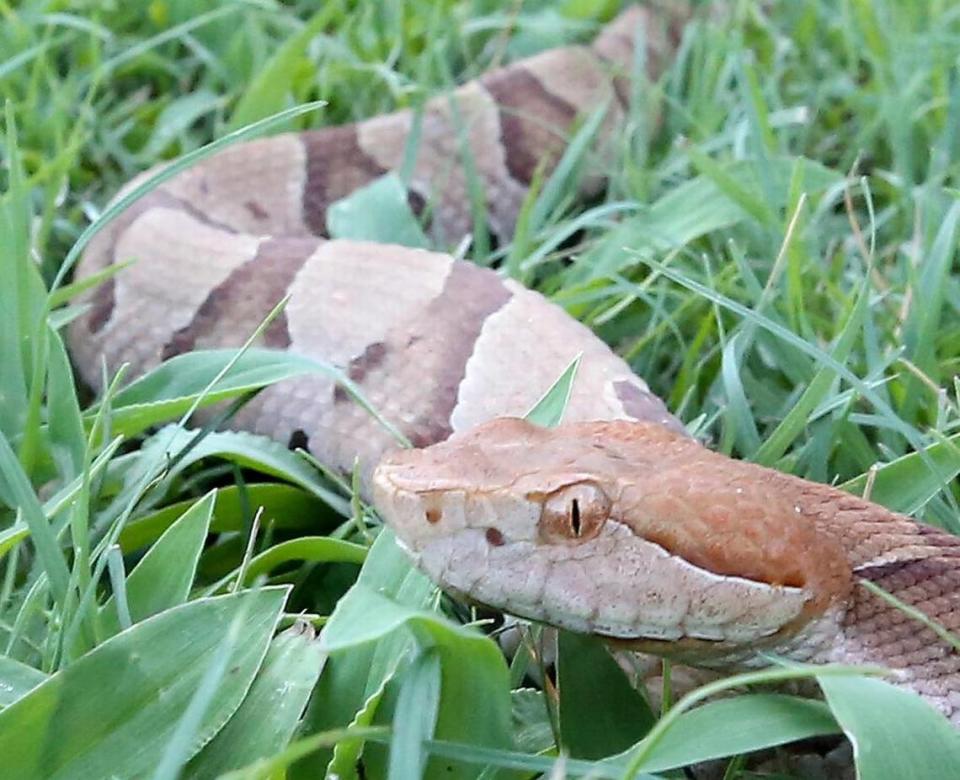
Myths about venomous snakes
Let’s bust a couple of venomous snake myths right off the bat:
▪ Venomous snake myth-busting #1: A commonly shared bit of advice is that most venomous snakes have a triangular or diamond-shaped head, while nonvenomous snakes have a tapered head. However, some nonvenomous snakes (such as a rat snake) can mimic the triangular shape of venomous snakes by flattening their heads when threatened (to avoid becoming the prey of another animal), so you can’t go by head shape alone.
▪ Venomous snake myth-busting #2: Another tricky but often shared tip is to check out the pupil shape. Venomous snakes have been said to have oblong pupils that look like a slit in the center of the eye, whereas nonvenomous snakes will have a round pupil. In fact, according to a document on the NC Wildlife website, a snake’s pupils can dilate just like human’s, and can look round. The best way to know if a snake is venomous is to know which venomous snakes are common in your area and know what they look like.
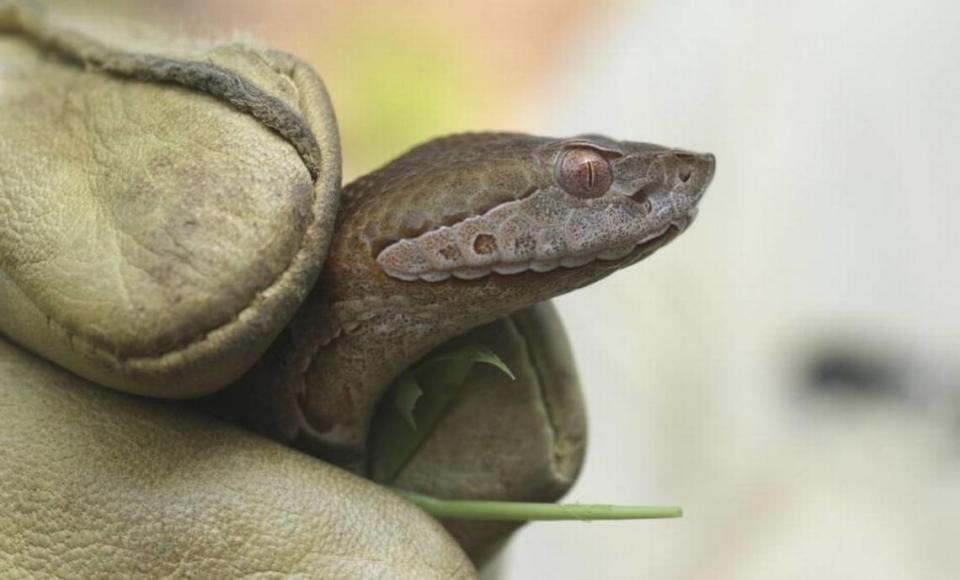
Are copperhead snake bites deadly?
Copperhead snake bites are rarely fatal to humans, but they can be painful and expensive to treat.
According to NC Poison Control in Charlotte, copperhead bites can be “severe,” but generally are not as bad as bites from other venomous North Carolina snakes. About half of all copperhead bites result in only mild swelling and pain, according to the center.
The center says it receives about 10 times the number of calls about copperhead bites than all other snakes combined.
“Antivenom is not always required to treat a copperhead bite, but it is important to be evaluated by a physician with expertise in treating venomous snakebites in order to make that determination,” Dr. Eugenia Quackenbush, an emergency physician with UNC Medical Center, told The News & Observer.
▪ Call the NC Poison Control at 1-800-222-1222 if you have questions about a snakebite.
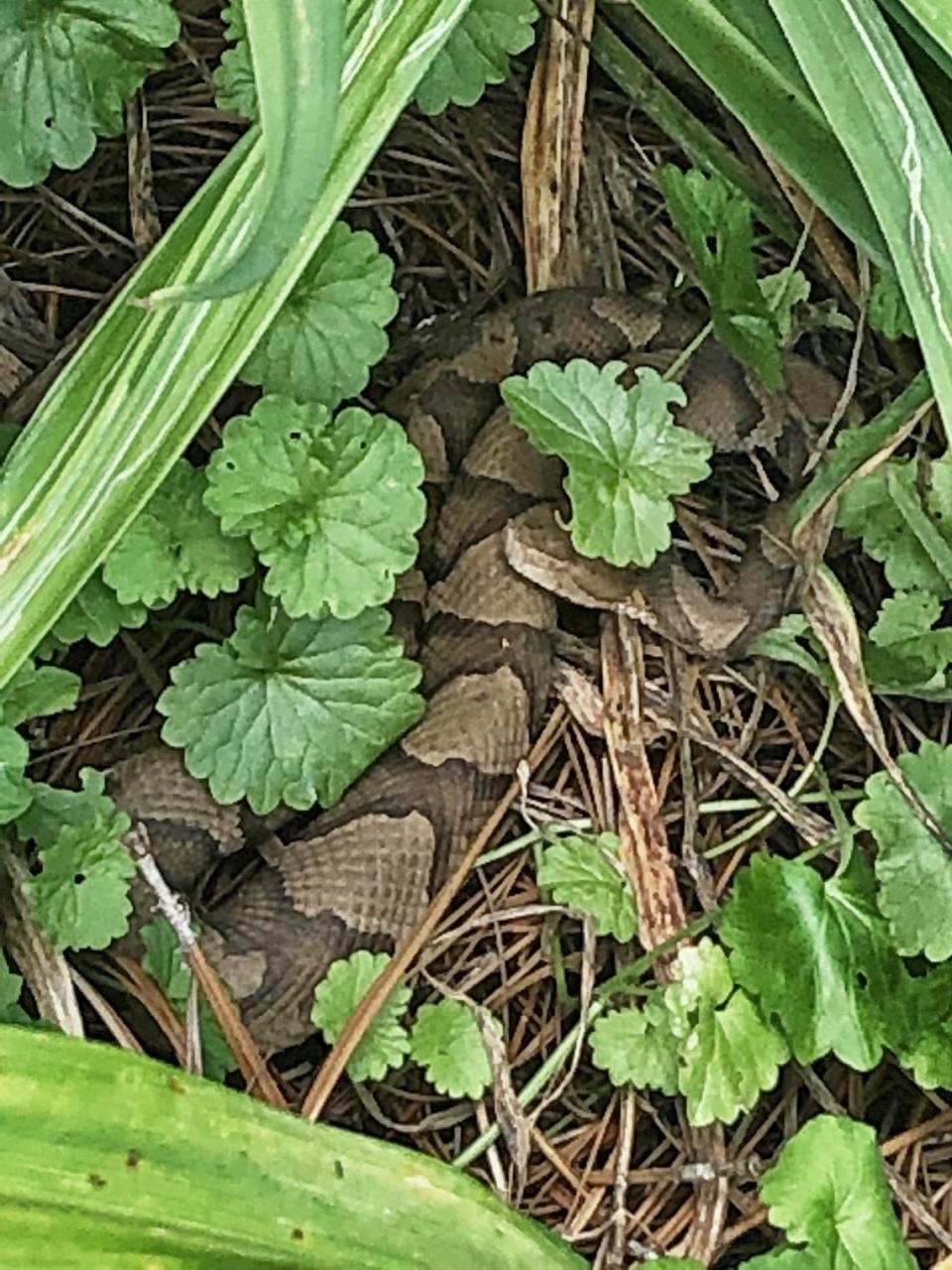
How to avoid copperhead snakes
Even though copperhead bites are rarely fatal to people, it’s best to use caution when working or playing outdoors, especially in areas where snakes are more likely to be hanging out.
The best way to not get bitten by a copperhead is to understand their habits and recognize that they may be encountered anywhere there is potential habitat.
▪ What are favored snake habitats? Copperheads love pine straw, dried leaves or brush, or dense, low-growing ground cover like English ivy. They also love wood piles and dry stack walls, which are border walls that are essentially stacked pieces of slate without mortar — those crevices make great homes for prey.
Jeff Beane, herpetology collection manager at the N.C. Museum of Natural Science in Raleigh, told The News & Observer in a previous report on copperhead snakes: “Common sense things like not putting your body parts into places you can’t see, not walking barefoot at night, not walking barefoot in thick vegetation, using a flashlight at night, not sticking your hands up underneath wood piles, watching what you are doing at all times, watching where you put your hands and feet will prevent the great majority of bites.”
▪ Where is snake prey? Copperheads (and other snakes) love to eat rodents, shrews, lizards, snakes, frogs and salamanders, and even insects, such as large caterpillars and cicada nymphs. So know that anywhere you might see those creatures, you could also see a snake.
▪ Be more cautious at night. Copperheads are active during the day or night time, but are largely nocturnal during hot weather, says NC Wildlife, so use more caution at dusk or dark. If you take dogs out, try to do that before dark, and if you need to run out at night to take out the trash, skip the flip-flops and wear shoes that cover your feet.
▪ Just leave them alone. While many bites occur when someone inadvertently puts a hand or foot near a copperhead, NC Wildlife notes that a large percentage of bites occur when a person is trying to kill or remove a copperhead.
The best thing to do if you encounter a copperhead is to leave the snake alone.
“Admire them from a safe distance and leave them alone,” Beane said. “Many bites and other injuries have occurred while people were attempting to kill snakes. No one was ever bitten by a snake while they were leaving it alone.”
If leaving it alone makes you nervous, you can always call a professional wildlife relocation expert to remove the snake from your yard.
When are copperhead snakes born?
Baby copperheads are mostly born in late August or early September, but a few may be born as early as mid-August or as late as early October, Beane said.
“Weather, geography, region and other factors can influence the exact time of birth,” Beane said. “But usually the last few days of August and the first few of September are peak for copperheads.”
Also, copperhead babies are born live, they do not hatch from eggs.
According to the North Carolina Wildlife Resources Commission, female copperheads can have one litter per year, and the litters can range from 2 to 18 snakes, which are 8 to 10 inches long when born.
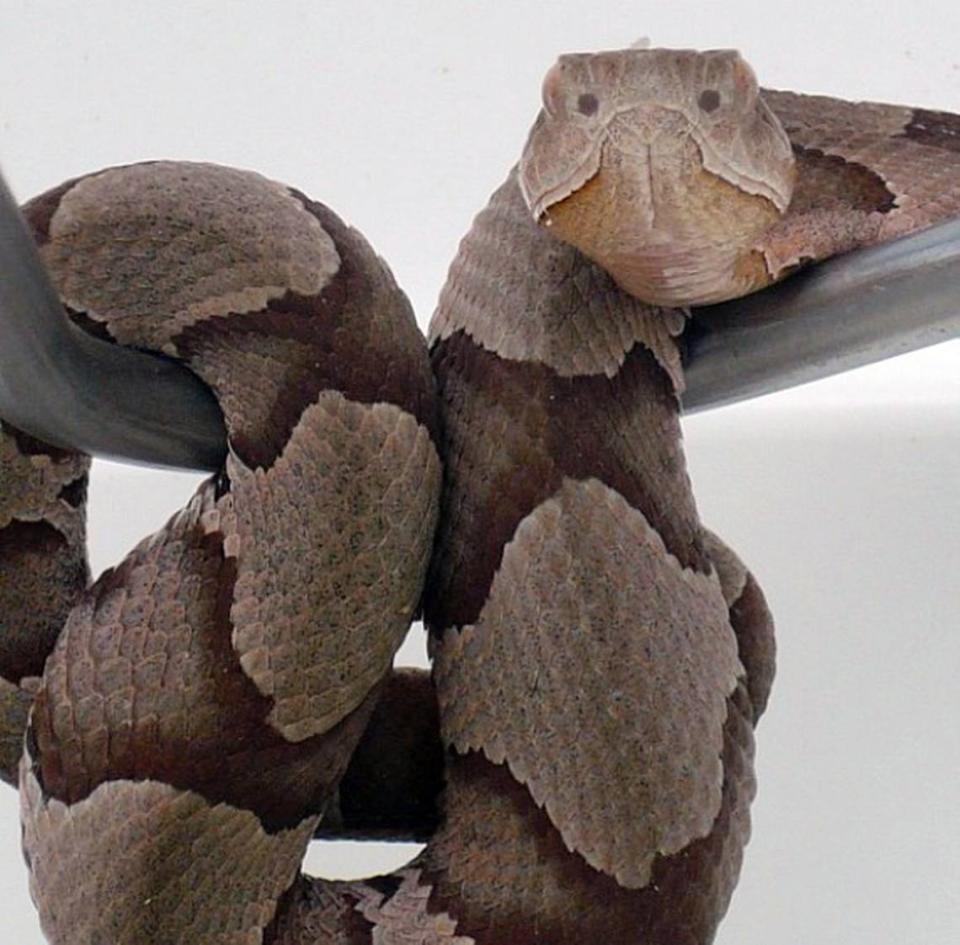
Is a baby copperhead bite more dangerous?
You’ll often hear that a bite from a baby copperhead is more dangerous than the bite from an adult, because the baby can’t control the amount of venom it uses.
When we asked Beane about that, his answer was: “It’s a little bit complicated.”
Beane confirmed that young copperheads may be less likely to control or withhold the amount of venom they inject, but that they also don’t have as much venom as a mature snake.
Here are some points to consider, says Beane:
▪ Defensive bites vs. prey-seeking bites. A copperhead will bite for two reasons: to kill and eat prey or to defend itself.
Beane explained that when striking prey to kill it and eat it, a baby copperhead will inject as much venom as necessary in order to achieve that goal. When a copperhead bites a human, that’s a defensive bite, and the snake isn’t likely to use as much venom in those cases (or sometimes, no venom at all).
“It is not advantageous for snakes to waste venom — it’s metabolically expensive to make, so they don’t want to bite anything other than prey items,” Beane said.
Beane notes that whenever a snake bites, it’s an instinctive response, and that the snake doesn’t “reason it out.” But, since a snake’s number one reason for biting is to kill and eat prey, snakes only bite people in an act of self-defense, Beane said.
“They would be unlikely to mistake something 100 times their size as a prey item,” Beane said.
▪ More concentrated venom? Beane told us that a newborn’s venom “may or may not be slightly more concentrated than adult’s,” but that because a larger copperhead has a lot more venom to inject, the larger snake would probably more than make up for any differences in chemical composition.
Plus, Beane said, a larger or more mature copperhead has longer fangs, which can penetrate a sock or thick skin, so it has more “delivery capacity” than a juvenile snake.
A mature copperhead can also “strike a greater distance and with more force and accuracy,” said Beane.
▪ Baby copperhead bites just aren’t as common. Most bites from copperheads on humans seem to be from adults, Beane said.
“I don’t hear much about people being bitten by newborns,” Bean said. “Personally, if I had to choose being bitten by a newborn copperhead or an adult, I would choose a newborn because of the potentially much smaller quantity of venom.”
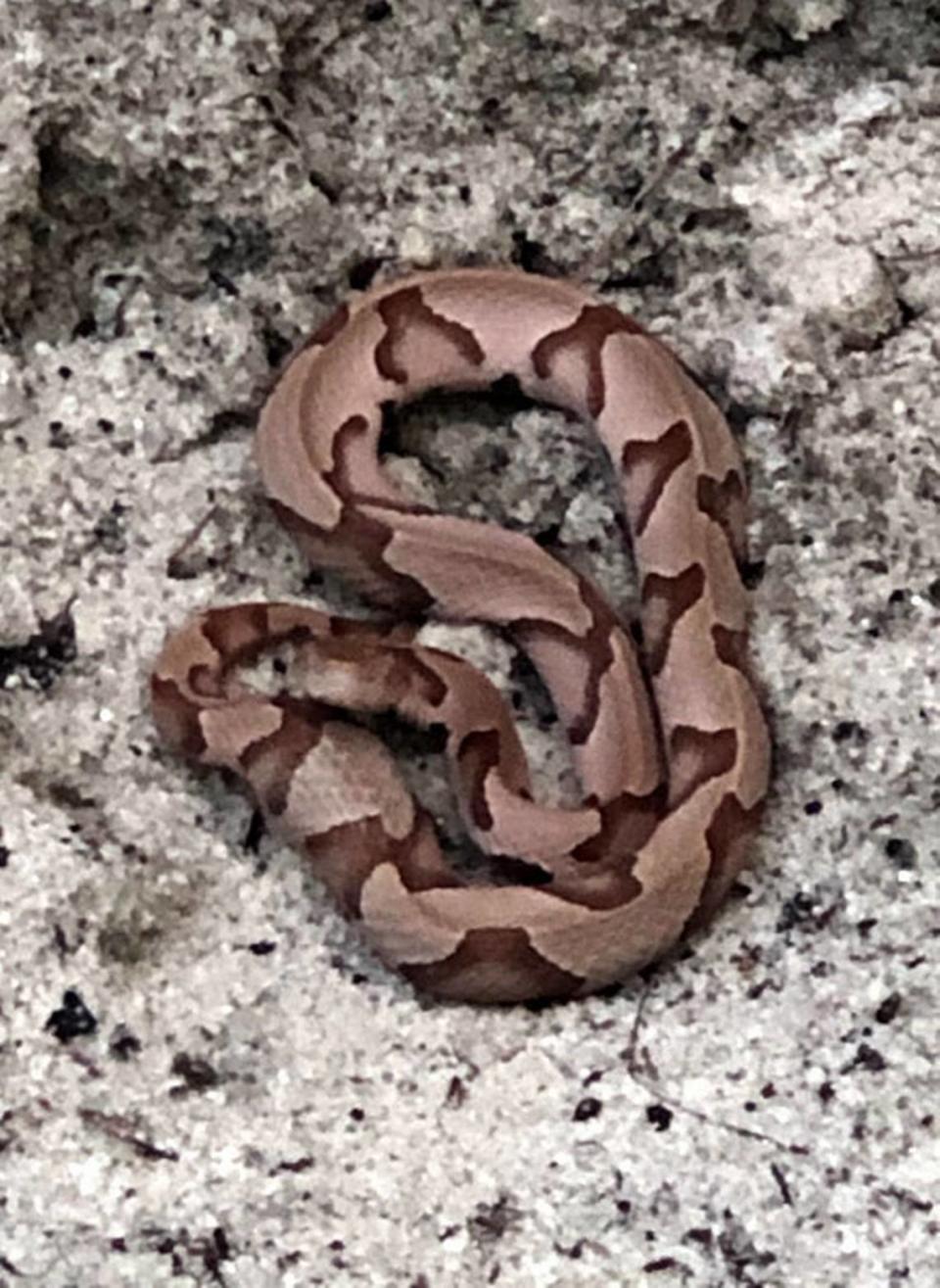
What happens if you’re bitten by a snake?
If you’re bitten by a copperhead (or other venomous snake), North Carolina Poison Control in Charlotte has the following advice:
DO:
Sit down and stay calm.
Gently wash the area with warm, soapy water.
Remove any jewelry or tight clothing near the bite site.
Keep the bitten area still, if possible, and raise it to heart level.
Call NC Poison Control at 1-800-222-1222.
DO NOT:
Cut the bitten area to try to drain the venom.
Ice the area (it can cause tissue damage).
Make and apply a tourniquet or any tight bandage. It’s better for the venom to flow through the body than for it to stay in one area.
Suck or use a suction device to remove the venom.
Attempt to catch or kill the snake.
If a snakebite victim is having chest pain, difficulty breathing, face swelling or has lost consciousness, NC Poison center says to call 911 immediately.
Dr. Michael Beuhler, NC Poison Control’s medical director, told The News & Observer for a separate story about snake bite treatment that antivenom is only sometimes necessary. The high cost of antivenom and risk of allergic reaction are two deciding factors against administering the drug, he said.
“You’re doing a risk to benefit ratio. Is the cost of antivenom worth it?” Beuhler said. “Most of the time, antivenom just gets you on your feet a few days quicker — is it necessary to spend this much money administering antivenom when you’ll be fine by the next month anyway?”
How much does it cost to treat a snake bite?
The News & Observer reported last summer that antivenom at WakeMed costs between $11,000 and $14,000 per vial, spokesperson Kristin Kelly said. For the typical initial dose of four to six vials, this costs at least $44,000.
UNC Health charges between $76,000 and $115,000 for the typical initial dose, The N&O previously reported. Duke Health declined to share current figures, but The N&O reported in 2020 that 12 vials cost $200,000.
Insurance and other negotiated discounts significantly lower the amount the patient is responsible for paying.

